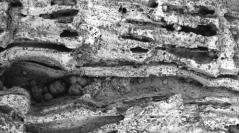

 European Journal of Taxonomy
2019 (516) - Pages 1-17
European Journal of Taxonomy
2019 (516) - Pages 1-17Coronuloid barnacles are epibionts of several marine vertebrates (including cetaceans and sea turtles) as well as invertebrates, and are assigned to two families of turtle barnacles (Chelonibiidae Pilsbry, 1916 and Platylepadidae Newman & Ross, 1976) and one family of whale barnacles (Coronulidae Leach, 1817). Chelonibiids and coronulids have a scanty, albeit significant fossil record extending back to the Eocene and Pliocene, respectively; in turn, the fossil record of platylepadids is limited to a single record from the Upper Pleistocene. Here we report on an isolated carinolateral compartment of Platylepas Gray, 1825, the type genus of the family, from Lower Pleistocene (Gelasian) epibathyal deposits exposed at Milazzo (Sicily, Italy). This specimen is here designated holotype of a new species, †Platylepas mediterranea sp. nov. We argue that, like most extant members of Platylepas, †P. mediterranea sp. nov. lived partially embedded in the skin of a sea turtle. This record of an extinct platylepadid – the first from the Mediterranean region and the second worldwide – pushes back the fossil record of Platylepadidae to the lowermost Quaternary, thus possibly supporting an even earlier (e.g., Neogene) timing for the origin of this family and adding a new chapter to the evolutionary history of one of the most diverse and successful lineages of epizoic crustaceans.
†Platylepas mediterranea sp. nov., sea turtles, Mediterranean Basin, evolution, symbiosis.